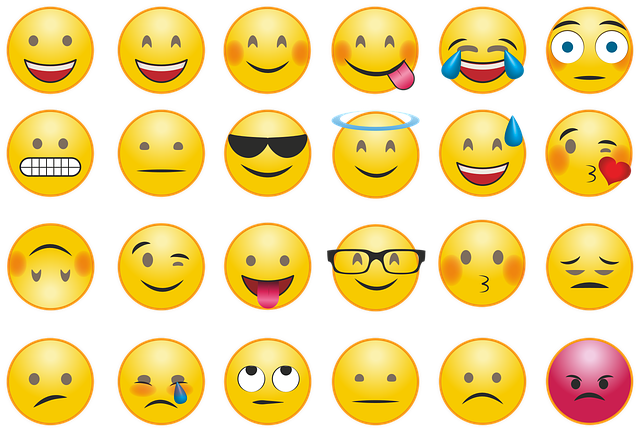[Ita-Eng] Emoji una risorsa per la comunicazione scritta.
[ITA]
Oggi, 17 luglio è la giornata mondiale delle Emoji.
Le emoticon, poi chiamate emoji, iniziano ad essere utilizzate stabilmente alla fine degli anni 90, con l'avvento della messaggistica istantanea, e la chat.
Le prime emoticon utilizzano segni grafici tipici della scrittura per ricordare espressioni facciali.
tra i più comuni ricordiamo l'emoticon del sorriso :-) e quella dell'espressione triste :-( tutt'ora utilizzate
Questa pratica non risale però ai giorni nostri.
Sono stati, infatti, ritrovati più documenti con simboli assimilabili agli smiley stilizzati, già verso la metà del 1600, e il più antico reperto risale addirittura al 1700 A.C (per saperne di più o vedere la foto vi lascio il link all'articolo su Focus).
Si tratta di un a brocca ittita sulla quale è inciso un sorriso stilizzato.
Se non puoi metterci la faccia... mettici la Faccina.
Uno dei grandi limiti della conversazione non verbale scritta, risiede nella difficoltà dell'interpretazione emotiva del messaggio.
Essa richiede infatti un vocabolario più profondo e maggiore coscienza e attenzione nell'utilizzo della parola, per esprimere quello che l'unione della comunicazione verbale e non verbale del corpo fanno con un movimento del viso, o con un gesto.
La necessità di condensare ulteriormente il messaggio scritto per il limite di caratteri imposto dai primi SMS, non faceva altro che ingigantire questa difficoltà innata.
La brevità dei messaggi, infatti, rendeva spesso impossibile, per chi li avesse ricevuti, intuire lo stato emotivo di chi li aveva inviati e anche comunicazione più semplici, o ironiche potevano facilmente essere fraintesi generando incomprensioni.
L'introduzione delle emoticon supera questa difficoltà permettendo una comunicazione non verbale del corpo anche da lontano. Attraverso un codice convenzionale, ma anche con l'aiuto della pareidolia.
La Pareidolia è l'istinto naturale di associare punti scollegati tra loro a forme riconoscibili (si pensi, come esempio, alle costellazioni)
Questi simboli scritti riuscivano quindi a generare un impatto visivo dell'espressione dell'altra persona.
Nel corso dell'evoluzione tecnologica, la messaggistica istantanea ha superato il limite dei caratteri, permettendo anche l'invio di file, video ed anche immagini. Così al segno grafico si sono sostituite le immagini stilizzate che tutti conosciamo ed utilizziamo (in alcuni casi abusandone).
Le emoji sono quindi entrate stabilmente nel nostro modo di comunicare le emozioni tanto da meritarsi una giornata mondiale.. ma chissà come si evolverà la comunicazione in futuro! Magari svilupperemo capacità telepatiche e non ne avremo più bisogno! :)
[ENG]
Today (July 17) is the World Emoji Day.
The emoticons, later called emojis, begin to be used permanently in the late 90s, with the advent of instant messaging, and chat.
The first emoticons were graphic signs typical of writing looking like facial expressions.
the smiley emoticon :-) and the sad :-(
However, this practice does not date back to the present day.
In fact, documents with symbols similar to stylized smileys, were found already in the mid-1600s, and the oldest finding dates back to 1700 BC (If you want to see the picture I you can find it here.
It is a Hittite jug with a stylized smile engraved on it.
If you can't put your face on it ... put the Emoji on it.
One of the greatest limitations of non-verbal written conversation lies in the difficulty of the * emotional interpretation * of the message.
In fact, it requires a deeper vocabulary and a greater awareness and attention in the use of words, to express what the verbal and non-verbal communication of the body do with a movement of the face, or with a gesture.
The need to write short messages, due to the characters limit imposed by the first SMS, did nothing but magnify this difficulty.
Short messages, in fact, often made it impossible, for those who had received them, to sense the emotional state of those who had sent them, and even simpler or ironic communication could easily be misunderstood.
The emoticons overcome this difficulty by allowing non-verbal communication of the body through a conventional code, but also with the help of the pareidolia.
Pareidolia is the natural instinct to associate unrelated points with recognizable forms (think, for example, of constellations), especially human faces
These written symbols generated a visual impact of the other person's expression.
Thanks to Technological Progress, allowing the sending of files, images and even videos, and the images, we all know and use, could replace graphic signs.
The emojis are permanently entered in our way of communicating the emotions, so as to deserve a world day .. but who knows how the communication will evolve in the future!
Maybe we'll develop telepathic abilities and we won't need them anymore! :)

This post was selected, voted and shared by the discovery-it curation team in collaboration with the C-Squared Curation Collective. You can use the #Discovery-it tag to make your posts easy to find in the eyes of the curator. We also encourage you to vote @c-squared as a witness to support this project.